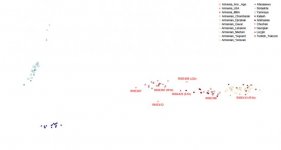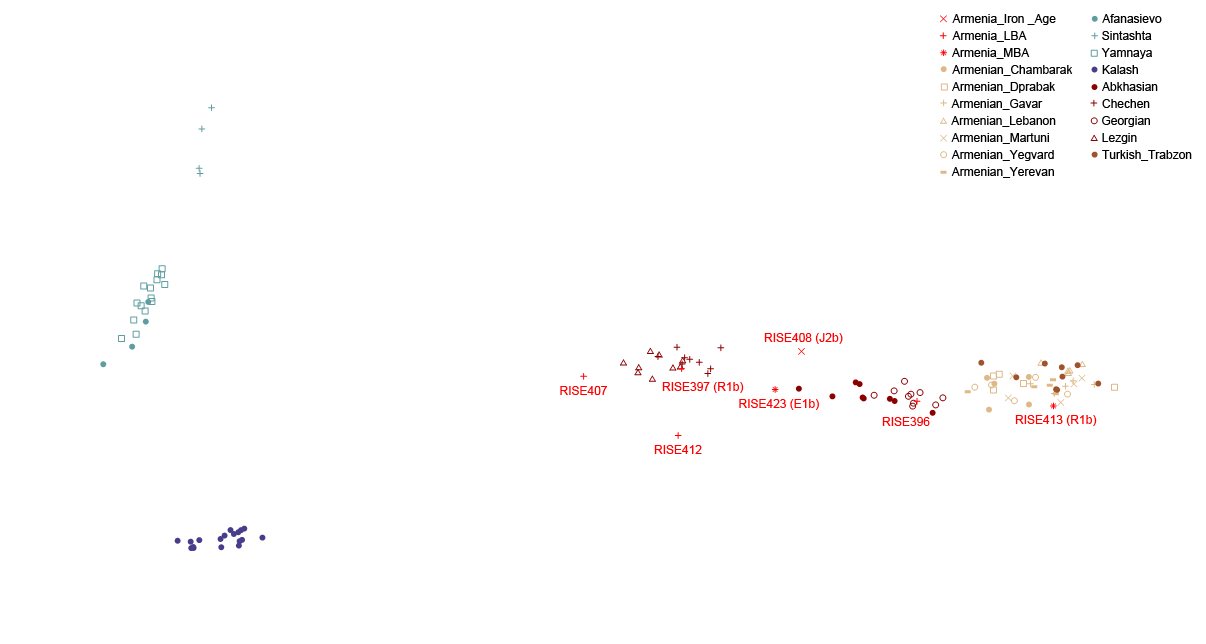Angela
Elite member
- Messages
- 21,823
- Reaction score
- 12,329
- Points
- 113
- Ethnic group
- Italian
[h=2]Genetic evidence for an origin of the Armenians from Bronze Age mixing of multiple populations[/h]See:
http://www.nature.com/ejhg/journal/vaop/ncurrent/full/ejhg2015206a.html#tbl1
"The Armenians are a culturally isolated population who historically inhabited a region in the Near East bounded by the Mediterranean and Black seas and the Caucasus, but remain under-represented in genetic studies and have a complex history including a major geographic displacement during World War I. Here, we analyse genome-wide variation in 173 Armenians and compare them with 78 other worldwide populations. We find that Armenians form a distinctive cluster linking the Near East, Europe, and the Caucasus. We show that Armenian diversity can be explained by several mixtures of Eurasian populations that occurred between ~3000 and ~2000 bce, a period characterized by major population migrations after the domestication of the horse, appearance of chariots, and the rise of advanced civilizations in the Near East. However, genetic signals of population mixture cease after ~1200 bce when Bronze Age civilizations in the Eastern Mediterranean world suddenly and violently collapsed. Armenians have since remained isolated and genetic structure within the population developed ~500 years ago when Armenia was divided between the Ottomans and the Safavid Empire in Iran. Finally, we show that Armenians have higher genetic affinity to Neolithic Europeans than other present-day Near Easterners, and that 29% of Armenian ancestry may originate from an ancestral population that is best represented by Neolithic Europeans."
There are other interesting bits:
"We observe that Armenians form a distinctive cluster bounded by Europeans, Near Easterners, and the Caucasus populations. More specifically, Armenians are close to (1) Spaniards, Italians, and Romanians from Europe; (2) Lebanese, Jews, Druze, and Cypriots from the Near East; and (3) Georgians and Abkhazians from the Caucasus (Figure 2b). The position of the Armenians within the global genetic diversity appears to mirror the geographical location of Turkey."
More relating to what I think we can now call EEF/Anatolian Neolithic:
"We then ran TreeMix allowing it to infer only one migration event, and revealed gene flow from the Iceman to Armenians, accounting for about 29% of their ancestry. The graph structure appeared robust in 100 bootstrap replicates with the first migration (highest weight and lowest P-value), always leading from the Iceman to Armenians (Figure 4"
http://www.nature.com/ejhg/journal/vaop/ncurrent/fig_tab/ejhg2015206f4.html#figure-titl
This is more confusing:
" We found signals of mixture from several African and Eurasian populations (Table 1, Figure 3). The most significantly negative f3 statistics are from a mixture of populations related to Sardinians and Central Asians, followed by several mixtures of populations from the Caucasus, Arabian Peninsula, the Levant, Europe, and Africa. We sought to date these mixture of events using exponential decay of admixture-induced LD. The oldest mixture events appear to be between populations related to sub-Saharan Africans and West Europeans occurring ~3800 bce, followed closely by a mixture of Sardinian and Caucasus-related populations. Later, several mixture events occurred from 3000 to 1200 bce involving diverse Eurasian populations (Table 1, Figure 3)."
Are they talking about a movement north from the area of Arabia around 3800 BCE? (so, close to 6,000 years ago?) What evidence do we have for an archaeological movement which would track that? IF that's the case, did it not affect the more westerly Anatolian Neolithic groups, or if it did affect them, then when did it affect them? What's the date for Barcin again? (Sorry, I'm in a rush) If the Aegean populations received diffused gene flow from this movement, then it would have affected all subsequent movements into Europe, including Bronze Age and Iron Age ones. Why also do they show it as a mixture of SSA and West Europeans? Also, is this another Alder "time estimation" problem?
The mixture of Sardinian and Caucasus related populations around that time makes more sense. IF the timing is correct, then perhaps ANE didn't arrive until shortly after that time.
http://www.nature.com/ejhg/journal/vaop/ncurrent/fig_tab/ejhg2015206f3.html#figure-title
http://www.nature.com/ejhg/journal/vaop/ncurrent/full/ejhg2015206a.html#tbl1
"The Armenians are a culturally isolated population who historically inhabited a region in the Near East bounded by the Mediterranean and Black seas and the Caucasus, but remain under-represented in genetic studies and have a complex history including a major geographic displacement during World War I. Here, we analyse genome-wide variation in 173 Armenians and compare them with 78 other worldwide populations. We find that Armenians form a distinctive cluster linking the Near East, Europe, and the Caucasus. We show that Armenian diversity can be explained by several mixtures of Eurasian populations that occurred between ~3000 and ~2000 bce, a period characterized by major population migrations after the domestication of the horse, appearance of chariots, and the rise of advanced civilizations in the Near East. However, genetic signals of population mixture cease after ~1200 bce when Bronze Age civilizations in the Eastern Mediterranean world suddenly and violently collapsed. Armenians have since remained isolated and genetic structure within the population developed ~500 years ago when Armenia was divided between the Ottomans and the Safavid Empire in Iran. Finally, we show that Armenians have higher genetic affinity to Neolithic Europeans than other present-day Near Easterners, and that 29% of Armenian ancestry may originate from an ancestral population that is best represented by Neolithic Europeans."
There are other interesting bits:
"We observe that Armenians form a distinctive cluster bounded by Europeans, Near Easterners, and the Caucasus populations. More specifically, Armenians are close to (1) Spaniards, Italians, and Romanians from Europe; (2) Lebanese, Jews, Druze, and Cypriots from the Near East; and (3) Georgians and Abkhazians from the Caucasus (Figure 2b). The position of the Armenians within the global genetic diversity appears to mirror the geographical location of Turkey."
More relating to what I think we can now call EEF/Anatolian Neolithic:
"We then ran TreeMix allowing it to infer only one migration event, and revealed gene flow from the Iceman to Armenians, accounting for about 29% of their ancestry. The graph structure appeared robust in 100 bootstrap replicates with the first migration (highest weight and lowest P-value), always leading from the Iceman to Armenians (Figure 4"
http://www.nature.com/ejhg/journal/vaop/ncurrent/fig_tab/ejhg2015206f4.html#figure-titl
This is more confusing:
" We found signals of mixture from several African and Eurasian populations (Table 1, Figure 3). The most significantly negative f3 statistics are from a mixture of populations related to Sardinians and Central Asians, followed by several mixtures of populations from the Caucasus, Arabian Peninsula, the Levant, Europe, and Africa. We sought to date these mixture of events using exponential decay of admixture-induced LD. The oldest mixture events appear to be between populations related to sub-Saharan Africans and West Europeans occurring ~3800 bce, followed closely by a mixture of Sardinian and Caucasus-related populations. Later, several mixture events occurred from 3000 to 1200 bce involving diverse Eurasian populations (Table 1, Figure 3)."
Are they talking about a movement north from the area of Arabia around 3800 BCE? (so, close to 6,000 years ago?) What evidence do we have for an archaeological movement which would track that? IF that's the case, did it not affect the more westerly Anatolian Neolithic groups, or if it did affect them, then when did it affect them? What's the date for Barcin again? (Sorry, I'm in a rush) If the Aegean populations received diffused gene flow from this movement, then it would have affected all subsequent movements into Europe, including Bronze Age and Iron Age ones. Why also do they show it as a mixture of SSA and West Europeans? Also, is this another Alder "time estimation" problem?
The mixture of Sardinian and Caucasus related populations around that time makes more sense. IF the timing is correct, then perhaps ANE didn't arrive until shortly after that time.
http://www.nature.com/ejhg/journal/vaop/ncurrent/fig_tab/ejhg2015206f3.html#figure-title







